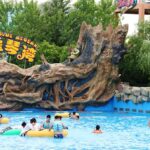Lianhua Village is historically renowned as a garden. Known for its ‘lotus blossoms in full bloom, with a hundred acres of brocade clouds,’ it is a unique sight in Wuxing. The Yuan Dynasty calligrapher Zhao Mengfu built his residence here, created a lotus pond, and constructed the Songyue Studio and Shuiyue Pavilion, hence the name Lianhua Village. Originally, it was the place where Zhao Mengfu studied in his childhood. Well-preserved during the Ming Dynasty, it was unfortunately destroyed by the end of the Qing Dynasty. In 1986, the relevant departments of Huzhou City rebuilt it and incorporated the adjacent Qian Garden, making it a contiguous area. The total area is 112 acres, with one-third being water surface, divided into three scenic areas. The West Area, adjacent to Hengtang Road, serves as the main entrance, with the gate’s plaque inscribed by the calligrapher Zhao Puchu. To the left upon entering is the stone tablet of Zhao Mengfu’s ‘Wuxing Fu,’ with Qingbian Residence in front of the tablet and Jifang Garden behind it. On the right is the Qing Sheng Pond, with Song Studio and Ou Bo Pavilion built by the pond, connected by a corridor. The Lianhua Peak to the west of the studio is an ancient remnant from Zhao Mengfu’s era, with the inscribed seal script of ‘Lianhua Peak,’ which is his own handwriting. The Dishan Building, Songsnow Studio, and Ou Bo Pavilion on the peak are memorial buildings of Zhao Mengfu’s life, where many of his masterpieces were completed. The park is open all year round from 08:00 to 18:00, with specific opening times subject to the actual situation of the scenic area on the day.
Lianhua Village Park
Lianhua Village is historically renowned as a garden. Known for its ‘lotus blossoms in full bl[...]









